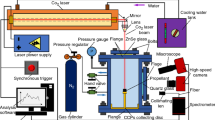Abstract
The influence of porous ammonium perchlorate (POAP) on the thermomechanical and combustion behavior of solid rocket propellants based on polyvinylchloride binder has been investigated. Differential scanning calorimetry, differential thermogravimetry, dynamic mechanical thermal analysis, and scanning electronic microscopy measurements were used for thermomechanical and thermal decomposition properties assessment. The results obtained indicate that lower glass transitions of the propellants and catalytic effect of combustion are obtained with POAP.











Similar content being viewed by others
Abbreviations
- nAP:
-
Normal ammonium perchlorate
- PoAP:
-
Porous ammonium perchlorate
- PVC:
-
Polyvinylchloride
- NCP:
-
Composite solid propellant formulated with normal ammonium perchlorate
- PCP:
-
Composite solid propellant formulated with porous ammonium perchlorate
- BDG:
-
Butyl diglycol
- DOP:
-
Dioctyl phthalate
References
De la Fuente JL. An analysis of the thermal aging behaviour in high-performance energetic composites through the glass transition temperature. Polym Degrad Stab. 2009;94:664–9.
Kohga M, Hagihara Y. Burning behavior of composite propellant containing fine porous ammonium perchlorate. Propellant Explos Pyrotech. 1998;23:182–7.
Kadiresh PN, Sridhar BTN. Experimental study on ballistic behavior of an aluminized AP/HTPB propellant during accelerated aging. J Therm Anal Calorim. 2010;100:331–5.
Sun YL, Li SF, Ding DH. Effect of ammonium oxalate/strontium carbonate on the burning rate characteristics of composite propellants. J Therm Anal Calorim. 2006;86:497–503.
Rocco JAFF, Lima JES, Frutuoso AG, Iha K, Ionashiro M, Matos JR, Suárez-Iha MEV. Thermal degradation of a composite solid propellant examined by DSC. Kinetic study. J Therm Anal Calorim. 2004;75:551–7.
Rocco JAFF, Lima JES, Frutuoso AG, Iha K, Ionashiro M, Matos JR, Suárez-Iha MEV. TG studies of composite solid rocket propellant based on HTPB-binder. J Therm Anal Calorim. 2004;77:803–13.
Davies JV, Jacobs PWM, Russel-Jones A. Thermal decomposition of ammonium Perchlorate. Trans Fraday Soc. 1967;63:1737.
Boldyrev VV. Thermal decomposition of ammonium perchlorate. Thermochim Acta. 2006;443:1–36.
Jacobs PW, Whithead HM. Thermal decomposition and combustion of ammonium perchlorate. Chem Rev. 1969;4:551–90.
Dorota M, Alexander K, Urszula F, Bogdan S, Paul M, David V, Jacek K. Low-temperature thermal decomposition of large single crystals of ammonium perchlorate. Chem Phys Lett. 2008;454:233–6.
Keenan AG, Siegmund RF. Thermal decomposition of ammonium perchlorate. Q Rev Chem Soc Lond. 1969;3(23):430–52.
Jacobs PW, Ng WL. Thermal decomposition of ammonium perchlorate single crystals. J Solid State Chem. 1974;4(9):315–22.
Singh G, Prem Felix S, Pandey DK. Studies on energetic compounds part 37: kinetics of thermal decomposition of perchlorate complexes of some transition metals with ethylenediamine. Thermochim Acta. 2004;411:61–71.
Kraeutle KJ. The thermal decomposition of orthorhombic ammonium perchlorate single crystals. J Phys Chem. 1970;74(6):1350–6.
Bolodyrev VV, Alexandrov VV. Thermal decomposition of ammonium perchlorate. Combust Flame. 1970;1(15):71–8.
Bircumshaw LL, Newman BH. Proceeding of the royal society. 1954. p. 227/115–132.
Leu AL, Yeh TF, Chang FM, Liu CS, Huang CC. Burning behavior of composite solid propellant containing porous ammonium perchlorate. Propellants Explos Pyrotech. 1989;14:108–12.
Lista EL. Solid porous, coated oxidizer, method of preparation and novel propellant. US Patent 3,830,672; 1974.
Klager K, Manfred RK, Lista EL. Burning behavior of porous ammonium perchlorate. In: Proceeding of 10th international annual conference of ICT, Karlsruhe; 1979. p. 283–97.
Leu AL, Wu RJ. Formulation effects on the burning rate of aluminized solid propellants. J Propuls Power. 1988;1(4):22–6.
Mezroua A, Hamel M, Medaour Y. Topograhy of the process of thermal decomposition of ammonium perchlorate under confinement. In: Proceeding of 41st international annual conference of ICT, Karlsruhe; 2010. p. 77/1–8.
Parr®. Introduction to bomb calorimetry No. 202M, Moline, II; 1978.
Al-Harthi A, Williams A. Effect of fuel binder and oxidizer particle diameter on the combustion of ammonium perchlorate based propellants. Fuel. 1998;77(13):1451–68.
Longuet B, Gillard P. Experimental investigation on the heterogonous kinetic process of the low thermal decomposition of ammonium perchlorate particles. Propellants Explos Pyrotech. 2009;34:59–71.
Kishore K, Sunitha MR. Effect of transition metal oxides on decomposition and deflagration of composite solid propellant systems: a survey. AIAAJ. 1979;17(10):1118–25.
Shin-Ming S, Sun-I C, Bor-Horng W. The thermal decomposition of ammonium perchlorate (AP) containing a burning-rate modifier. Thermochim Acta. 1993;223:135–43.
An-Lu L, Tsao-Fa Y. The thermal behavior of porous residual ammonium perchlorate. Thermochim Acta. 1991;186:53–61.
Sara C, Manfred AB, Kalus M, Luciano G. Ageing of HTPB/Al/AP rocket propellant formulations investigated by DMA measurements, Sol-Gel and GPC analysis In: Proceeding of 41st international annual conference of ICT, Karlsruhe; 2010. p. 42/1–38.
Lessard P, France B. Effect of porosity on the burn rate of a gas-generating composition. Propellants Explos Pyrotech. 2003;28:132–7.
Banerjee S, Chakravarthy SR. Ammonium perchlorate-based composite solid propellant formulations with plateau burning rate trends. Combust Explos Shock Waves. 2007;43:435–41.
Author information
Authors and Affiliations
Corresponding author
Rights and permissions
About this article
Cite this article
Mezroua, A., Khimeche, K., Lefebvre, M.H. et al. The influence of porosity of ammonium perchlorate (AP) on the thermomechanical and thermal properties of the AP/polyvinylchloride (PVC) composite propellants. J Therm Anal Calorim 116, 279–286 (2014). https://doi.org/10.1007/s10973-013-3517-1
Received:
Accepted:
Published:
Issue Date:
DOI: https://doi.org/10.1007/s10973-013-3517-1




